A Cardinal And A Jewel
/8 Comments/in Flowers, Gardening/by Lee ReichAnd This Year’s Winner Is . . .
Organizations annually tout their “plant of the year.” There’s the Perennial Plant Association’s 2017 plant of the year butterfly weed (Asclepias tuberosa); Proven Winners 2017 Landscape Plant of the Year is Yuki Cherry Blossom Deutzia; American Conifer Society Collectors’ Conifer of the Year is Primo Eastern Arborvitae (Thuja occidentalis ‘IslPrim’); Assembly magazine’s 2016 Plant of the Year is Bosch Rexroth . . . whoops, the last is an assembly plant (hydraulic motors and pumps). Anyway, you get the picture.
How about a new category, the Weed of the Year? Here on my farmden, I nominate and elect jewelweed (Impatiens capensis). This weed is all over the place this year, even far from where it’s been in the past. For this weed, being all over the place is its only flaw.
On the positive side, jewelweed is a pretty plant with very succulent stems sporting orange, sometimes yellow flowers. 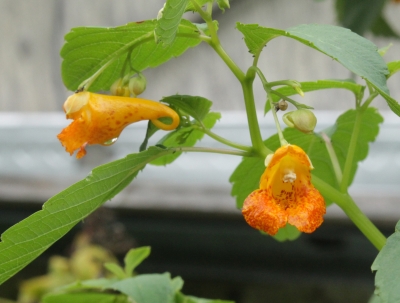 It’s also been called touch-me-not for the way its seed capsules burst open with the slightest touch to project their seeds many feet — a useful characteristic for helping a weed spread although it doesn’t explain jewelweed’s spreading here in one season over a hundred feet and to the other side of my house. It’s close relative, the widely planted annual flower, impatiens, does the same thing without becoming weedy; both plants also enjoy and flower in either sun or deep shade.
It’s also been called touch-me-not for the way its seed capsules burst open with the slightest touch to project their seeds many feet — a useful characteristic for helping a weed spread although it doesn’t explain jewelweed’s spreading here in one season over a hundred feet and to the other side of my house. It’s close relative, the widely planted annual flower, impatiens, does the same thing without becoming weedy; both plants also enjoy and flower in either sun or deep shade.
Jewelweed often grows as a neighbor to poison ivy, which perhaps by some odd reasoning (to me) gave it a reputation for use as a treatment for poison ivy. My friend Bob, usually a clear thinker and very susceptible to poison ivy, decided to treat his rash, one year with jewelweed. He reported a success, as an afterthought mentioning that he applied it in conjunction with cortisone. (I’ll expect a lot of feedback, testimonials for jewelweed.)
Jewelweed’s main asset is how easy it is to remove. Even large stalks lift easily out of the ground, roots intact, with minimal soil disturbance. A machete or scythe slices easily through the stalks without the slightest resistance to decapitate the plants.
Each year in the garden is different. Jewelweed’s plans for next year won’t be evident until next June.
Red In The Shade!

Cardinal flower I planted
Slicing through a stand of jewelweed with my scythe in the deep shade along the seasonal, small stream (a ditch) in front of my property, I was taken aback by a 3-foot-high spike of fire engine red flowers. More scything, and then another spike appeared. I thought back to spring, and remembered planting cardinal flower (Lobelia cardinalis) along the stream/ditch this past spring.
Cardinal flower never ceases to take my breath away. Deep shade is not usually home to lots of showy flowers, and especially not flowers in traffic stopping colors. Only a few times in my life have I come upon cardinal flowers in the wild, and — you guessed it — each time they took my breath away.

Wild cardinal flower
Each time they were also in deep shade alongside water. Hence my choice of site for last spring’s planting.
Cardinal flowers are easily grown from seed, and no need to have a lot of them for bold effect. The plant to grow is the species, not one of the “improved” varieties. Many varieties have been bred or selected, including Alba (white flowers), Heather Pink, Angel Song (salmon and cream flowers), Ruby Slippers, and Twilight Zone (pink flowers). Color of the straight species is usually red, a very pure red, untainted by a hint of blue as are so many other red flowers.
Two Weeds(?)
Jewelweed and cardinal flower have much in common: both are native, both grow in shade, and both are pretty plants. Jewelweed is a self-seeding annual.
Cardinal flower is a perennial, unfortunately a short-lived perennial. It does self-seed to some degree for new plants to replace dead ones, but not enough for my needs. I grew my originals from seed, which is not at all difficult, and intend to do so again. If only cardinal flower could learn some reproductive habits from its neighbor in the shade.
Savin’ Seeds, Killin’ Weeds
/3 Comments/in Fruit, Gardening, Pests, Vegetables/by Lee Reich
Bolting Plants
Last week I was admiring a vegetable garden where just about every lettuce plant was reaching skyward, with flower buds about to cap the tops of the spires. Isn’t that the wrong way to grow lettuce?
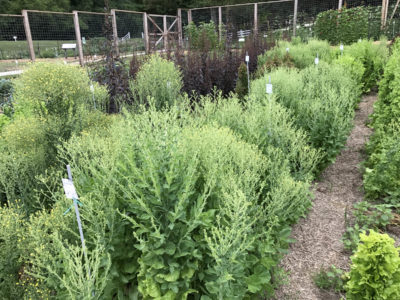 Lettuce that flowers — “goes to seed” — becomes bitter and tough. In my own garden, I aspire to have no lettuce spires by sowing lettuce seeds every couple of weeks for a regular harvest of mild-flavored, succulent leaves or heads. The plants don’t have time to bolt.
Lettuce that flowers — “goes to seed” — becomes bitter and tough. In my own garden, I aspire to have no lettuce spires by sowing lettuce seeds every couple of weeks for a regular harvest of mild-flavored, succulent leaves or heads. The plants don’t have time to bolt.
Those bolting lettuces I was admiring were in a garden in Iowa, one of the gardens at the Seed Savers Exchange (www.seedsavers.org), an organization that every gardener should know about and a garden that I should have not waited so long to visit. The mission of Seed Savers Exchange is to save and preserve heirloom seeds, which are varieties that have been passed on down among generations of farmers and gardeners. Taste some heirloom tomatoes and it’s understandable why these varieties have been saved and passed on. Belgian Giant tomato may not have the smooth, round shape of a modern Big Boy tomato, but this heirloom is well worth growing for its complex, sweet-tart flavor.
One way that Seed Savers fulfills their mission is by growing and saving many varieties of seed. Hence the bolting lettuces I saw there. Some varieties of vegetables, such as most squashes, tomatoes, and cucumbers, spread their pollen too freely. To keep these varieties seed “true,” contamination from foreign pollen is prevented by growing all plants of a particular variety in fine-mesh, insect-proof enclosures.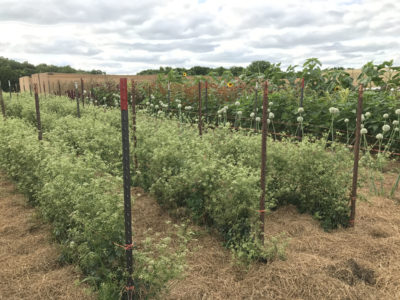
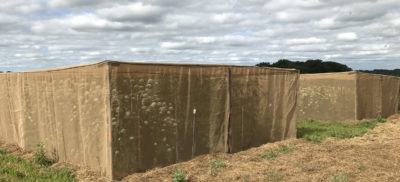
The Seed Saver mission is also fulfilled by so-called “participatory preservation.” An over 13,000 member network of gardeners grow seeds and share them — to the tune of over 23,000 varieties — through an online seed exchange. Anyone can browse the listings but only members can request the seeds.
Not that non-members don’t have access to any of these seeds. Every year, Seed Savers Exchange publishes a seed catalog, from which anyone can order seeds. The names of the old varieties themselves make some of the seeds irresistible: Tolli’s Sweet Italia pepper (better name than flavor), Green Arrow Pea (excellent flavor and high yielding), Jelly Melon cucumber (very interesting name and appearance, but I have yet to try it).
What To Do With Weeds
Ten days absence from my garden, with warm, sunny weather interspersed with rainy days adding up to two inches of rainfall, wrought big changes. Sweet corn and polenta corn reached well over 5 feet in height, flopping stems of staked tomatoes were in desperate need of tying, blueberry stems bowed down with their weight of plump, ripe berries, and . . . weeds were abundant.
Ninety percent of the weeds were Canadian thistle, crabgrass, purslane, 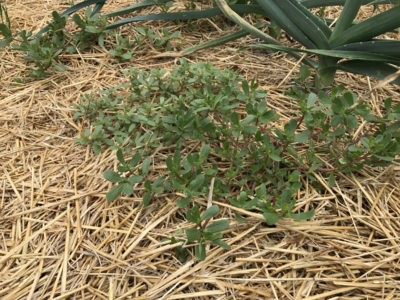 pigweed, common yellow wood sorrel (Oxalis sricta) and — my worst weed — creeping woodsorrel (Oxalis corniculata). I’m jerking each thistle out with a gloved hand. Yes, roots left in the ground will resprout. I’ll just keep jerking them out until they expend all their stored fuel and before new shoots can start pumping new fuel down to the roots, and the plants will die. I poke my hori-hori knife right at the roots of crabgrass and toss the severed tops into the compost bucket.
pigweed, common yellow wood sorrel (Oxalis sricta) and — my worst weed — creeping woodsorrel (Oxalis corniculata). I’m jerking each thistle out with a gloved hand. Yes, roots left in the ground will resprout. I’ll just keep jerking them out until they expend all their stored fuel and before new shoots can start pumping new fuel down to the roots, and the plants will die. I poke my hori-hori knife right at the roots of crabgrass and toss the severed tops into the compost bucket.
Yellow wood sorrel is easy, and sort of fun, to remove; pull the plant and the whole thing comes out easily. Creeping woodsorrel is another story: With brittle stems that creep just below ground level and dirt-colored leaves, it’s hard to see and hard to remove. Most effective is a spray of household vinegar, repeated each time new stems grow.
The way to remove purslane and pigweed is to harvest it — yes, for eating. Unfortunately, I don’t like purslane, so I weed it. But pigweed is a delicious cooked green. I wish I had more of this weed; it cooks down a lot and the harvest was over after two dinners.
Bye, Bye Black Currants
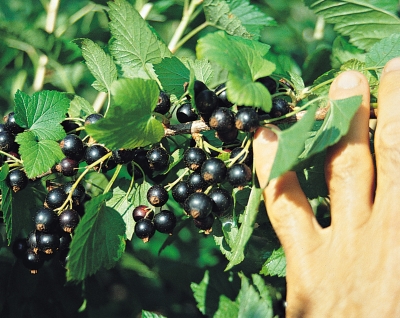
Belaruskaja black currants
I mourn the passing — okay, “mourn” is a bit too strong — of fresh blackcurrants. The harvest was bountiful and long lasting, but now is over. Over twenty quarts of them are in the freezer but those are for eating through the winter.
COMPOST TEA: SNAKE OIL OR ELIXIR? BLACK CURRANTS…
/17 Comments/in Fruit, Gardening, Pests/by Lee Reich
Tea For Plants?
Has your garden had its tea this morning? Tea is all the rage for plants and soils these days. Compost tea. And not just any old compost tea, but tea you steep in water that’s aerated just like an aquarium.
Compost tea steeped the old way, by hanging a burlap sack of compost in a bucket of water for a few days, was one way to provide a liquid feed to plants. The liquid feed wasn’t particularly rich but did provide a wide range of nutrients that leached from the compost, and was convenient for feeding potted plants.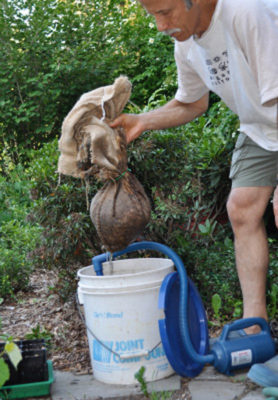
The new, aerated compost teas are billed as an efficient way to transfer beneficial microorganisms from compost into the soil or onto plant leaves. After all, spraying a little tea is less work than pitchforking tons of compost. In the soil, the little guys can spread their goodness, fighting off plant diseases and generally making plants healthier. Or so goes the logic and the promotional material.
Aerated compost tea (ACT) is big business these days, with people selling compost tea, compost tea brewers, and services for testing compost teas. Compost tea is more than big business; it’s bordering on religion (as anyone who criticizes compost tea soon finds out).
In fact, aerated compost tea is not the panacea it’s trumped up to be. Many independent studies have found the tea to be of no benefit, or even detrimental. Occasionally, human pathogens have been found lurking in compost tea.
In The Interest Of Science
I have a friend who believes in compost tea, so in the interest of science I agreed, on his urging, to try it out. To make sure any lack of efficacy could not be blamed on the tea itself, he sent me some compost, a brewer, and instructions for brewing and application. Interestingly, he told me not to try it out in my vegetable garden, because my garden was “too organic”(!)
Long story short: I applied tea to my lawn and to some vegetables in a relatively poor soil at a local farm, and the result was . . . (drum roll) . . . nothing, nada, rien, zip.
Tea Doesn’t Make Sense
All the buzz about compost tea bypasses the fundamental question of why compost tea would limit plant disease when sprayed on plant leaves? The theory goes that the good microorganisms colonize leaves to displace and/or fight off the bad guys.
Compost tea contains some of the microorganisms from the compost that made the tea. These microorganisms are normally found in soils and, of course, composts. But why, evolutionarily speaking, would these microorganisms provide any benefit on plant leaves, for disease control or any other purpose? Furthermore, these microorganisms evolved in a dark, nutrient and moisture rich environment. Why would they survive on a sunny, dry, nutrient poor leaf? The same goes for soils: If the soil has the right environment for a particular set of microorganisms, they generally are there; apply microorganisms to a soil lacking the needed environment and those microorganisms cannot survive.
Occasional research papers report positive effects of compost tea for thwarting plant diseases. I contend that if you spray just about anything on a plant leaf and measure enough plants closely enough, you’ll turn up some measurable response to the spray. That response might be very transitory and very small, but, with the right equipment or instrumentation, you’ll measure some effect. Whether that effect is of biological or practical significance is another story.
With that, I suggest someone begin a series of experiments to see the effect on plant diseases of spraying — say — milk solutions on plant leaves. Wait! A web search tells me that milk sprays have been tested and are, in fact, effective in controlling plant viruses, powdery mildew, and other diseases. In contrast to compost tea, which provides microorganisms but little of the food they need to survive, milk provides a smorgasbord of nutrients to whatever microorganisms tag along for the ride.
On the basis of the evidence, I’d go with milk rather than tea for my plants. And I’ll take my milk without tea.
Black Currants, Mmmmm
Moving on to something noncontroversial, my first black currants of the season ripened June 26th this year. Come to think of it, black currants may not be noncontroversial. Black currants have a strong, very

Belaruskaja black currants
distinctive flavor, loved by some people, abhorred by others. The flavor starts out refreshingly tart as your teeth break the skin and then becomes sweeter and cooling, with a rich, resiny flavor, as you continue.
I count myself among the lovers of black currants, right up there
with blueberries in my book. Black currants earned a whole chapter in my book, Uncommon Fruits for Every Garden. Although humans are divided on whether or not they enjoy fresh black currants, pretty much everyone loves the fruit concocted into jams and baked goods. They also flavor the liqueur cassis, I’ve used them to flavor beer.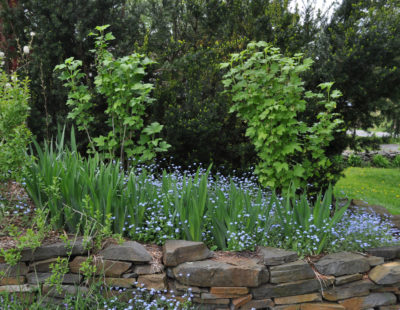
Let’s be clear about the fruit in question. Black currants are not the same fruit as “dried currants.” Those currants are raisins made from dried Black Corinthe grapes, a name which was bastardized to “black currant.”
Black currants are borne on medium-sized bushes whose leaves, when brushed against, emit a strong, also resiny aroma. The leaves are sometimes brewed into tea — for humans, not plants.

